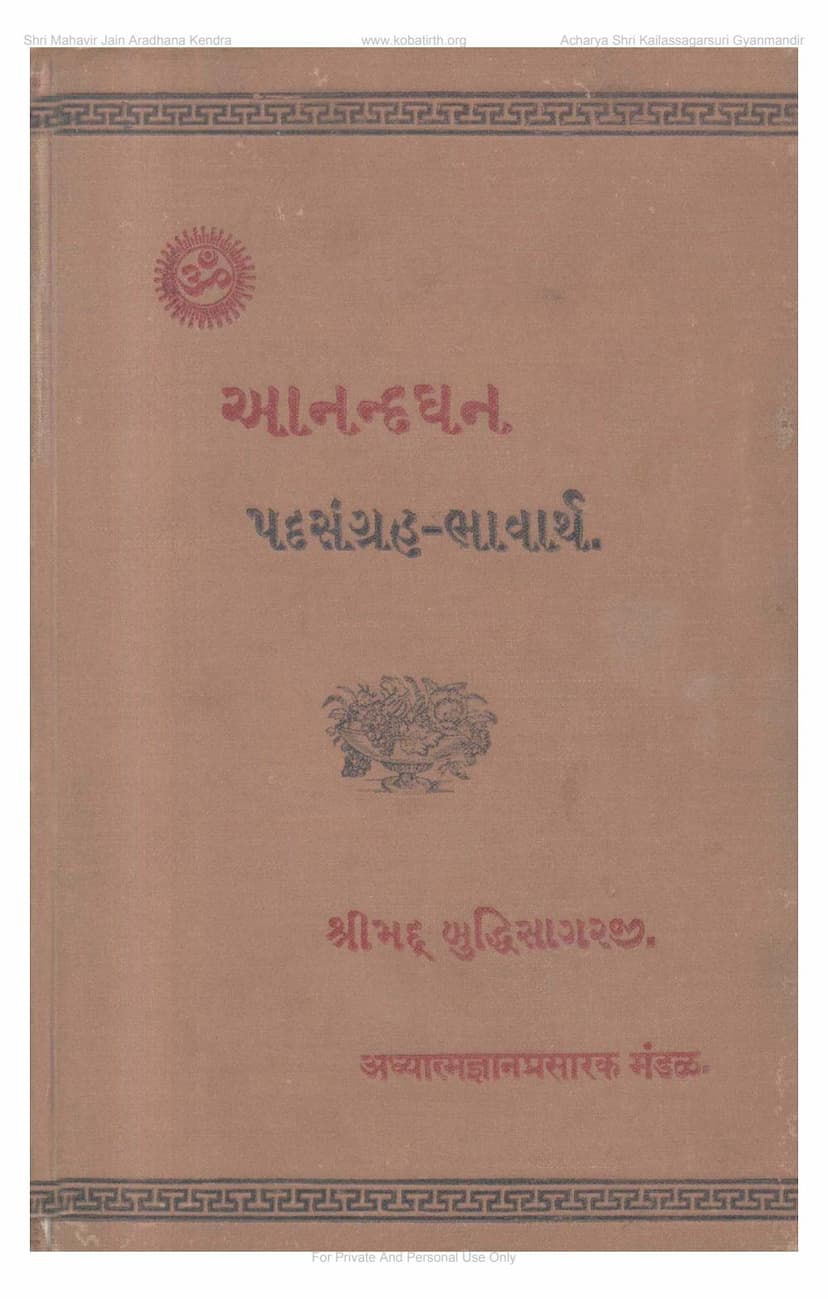Anandghanpad Sangraha Bhavarth
Added to library: September 1, 2025

Summary
This Jain text, "Anandghanpad Sangraha Bhavarth" by Buddhisagar, published by Adhyatma Gyan Prasarak Mandal, is a profound exploration of Jain spiritual philosophy, primarily focusing on the teachings and life of Shri Anandghanji, a significant Jain monk. The text delves deeply into the concept of "Adhyatma" (spirituality) and its paramount importance in achieving liberation.
Here's a comprehensive summary of the text's key themes and content, based on the provided pages:
Core Theme: The Supremacy and Necessity of Adhyatma (Spirituality)
The central argument throughout the text is that Adhyatma, or spiritual knowledge and practice, is the highest form of knowledge and the ultimate path to true happiness and liberation. The author, Buddhisagar, emphasizes that understanding the soul, its true nature, and its relationship with the material world is crucial for spiritual progress.
Key Concepts and Content:
- Shri Anandghanji's Life and Teachings: The text is heavily influenced by the life and spiritual insights of Shri Anandghanji. It aims to elucidate the profound meaning behind his spiritual songs (Padas) and his overall spiritual journey. The author meticulously details various aspects of Anandghanji's life, his wisdom, his detachment, his profound understanding of Jain scriptures, and his ability to connect with the masses through his spiritual verses.
- The Nature of the Soul (Atman): A significant portion of the text is dedicated to defining and explaining the nature of the soul. It describes the soul as eternal, unchanging, pure consciousness, and the ultimate source of true happiness. The soul's inherent divinity and its potential for liberation are highlighted.
- The Path to Liberation: The text outlines the spiritual path to liberation, which involves detachment from worldly pleasures and materialistic possessions, understanding the difference between the soul (Atman) and the body (physical realm), and cultivating virtues like equanimity (Samata), non-attachment, and spiritual contemplation (Dhyana).
- The Importance of the Guru: The necessity of a true Guru (spiritual guide) is repeatedly stressed for attaining genuine spiritual knowledge and progress. The Guru's guidance is depicted as essential for understanding complex spiritual concepts and navigating the path to liberation.
- Critique of Ritualism without Inner Understanding: While not entirely dismissing external rituals, the text subtly points out that mere outward actions without inner spiritual understanding are insufficient. True spirituality lies in the inner transformation of the soul and the cultivation of virtues like equanimity and detachment.
- The Power of Adhyatma: The text elaborates on the transformative power of Adhyatma, explaining how it can lead to inner peace, detachment from worldly desires, and ultimately, the attainment of liberation (Moksha). It contrasts the fleeting nature of worldly pleasures with the eternal bliss of the soul.
- Overcoming Obstacles: The text addresses various obstacles on the spiritual path, such as ego, attachment, worldly desires, and the influence of negative thoughts (kashayas). It advocates for self-discipline, introspection, and consistent spiritual practice to overcome these hurdles.
- The Philosophy of Nayavada (Syadvada): The text touches upon the Jain philosophical principle of Nayavada (manifold perspectives), emphasizing that truth is relative and can be understood from multiple viewpoints. This principle helps in reconciling seemingly contradictory aspects of reality and understanding the soul's multifaceted nature.
- The Role of Devotion (Bhakti): Bhakti is presented as a vital component of the spiritual journey, fostering love and devotion towards the divine, which in turn aids in soul purification and the path to liberation.
- Spiritual Practices: The text implicitly or explicitly encourages practices like meditation (Dhyana), contemplation, self-reflection, and the cultivation of virtues to realize the soul's true nature.
- Metaphorical Language: The text utilizes rich metaphorical language, comparing the soul to a lotus, the divine to a moon, and spiritual knowledge to a sun, to convey profound spiritual truths in an accessible manner.
- Rejection of Materialism: A strong undercurrent throughout the text is the critique of excessive attachment to material possessions, wealth, and worldly status, highlighting their impermanence and their hindrance to spiritual progress.
Structure and Style:
The text is written in Gujarati and appears to be a commentary (Bhavarth) on the Padas (spiritual songs) of Shri Anandghanji. It includes extensive explanations, philosophical discussions, and lyrical verses, likely derived from Anandghanji's compositions. The author, Buddhisagar, presents a detailed analysis, often referencing scriptures and previous Āchāryas to support his points.
Overall Message:
The "Anandghanpad Sangraha Bhavarth" serves as a guide for spiritual seekers, urging them to turn inward, understand the soul's true nature, and pursue Adhyatma as the ultimate means to achieve lasting peace, happiness, and liberation. It celebrates the wisdom of Shri Anandghanji and aims to make his spiritual teachings accessible to a wider audience.